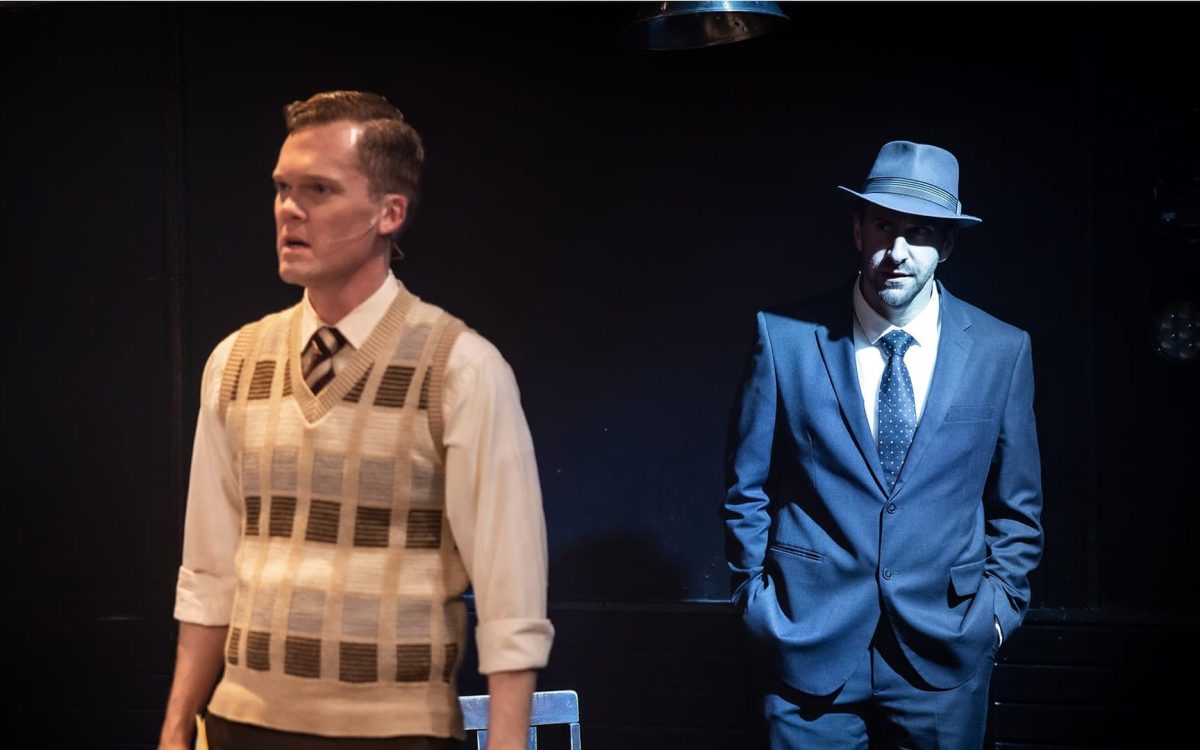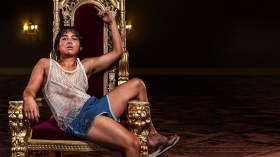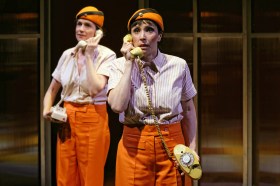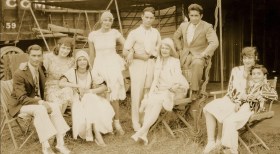City of Angels at Hayes Theatre is a triumph of noir and comicality. Tending to the perimeters of the classic whodunnit genre and bebop jazz, the cast and band put on a unified performance for the visual and auditory senses.
Before there were movies, there was writing. At least that’s what the musical City of Angels considers canon, in its irreverent pastiche of the 1940s Hollywood heyday. The voiceovers are filtered through an imaginary smog of tobacco, and everyone – whether they like it or not – is in a movie.
The split scenes take place in the real-world writer’s room of author Stine and the sepia-tinged narrative of the private eye, Stone. Its storytelling is deliberately backwards. Each sequence that rewinds before our eyes is an audience high-note, the cast committed to every second in which they backtrack in Pig Latin mumbo jumbo.
In the first act the audience is told that people don’t see themselves as others write them. This certainly remains the case with Stine and Stone, and the two-hander pairings of the other characters in the cast. Secretary Donna (Oolie in Stine’s film), wife and love interest Gabby (Bobbi), stepdaughter Mallory (Avril) make up a vibrant portion of the mainboard and, even when separated in life and script, they always seem to reprise elements of their personality that shine through in both.
There is Aaron Tsindos who is the perfectly churlish Detective Stone, matching Glenn Hill’s Stine beat for beat with his ranging one-liners. Shannen Alyce Quan’s Donna/Oolie is simultaneously deprecating, and painfully aware of the gaps she is filling in the lives of both men for whom she pines. Her voice is a natural illumination of her talent.
Similarly, Mia Morrissey uses her husky alto in Bobbi’s ‘With Every Breath I Take’ to great effect, cutting across the slow build of the brass accompaniment. On the topic of brass – the live band was a tremendous contribution to Cy Coleman’s snappy score. Music directors Abi McCunn and Damon Wade have led their instrument-wielding team to show-stopping heights.
The musical lives in the 1940s, so it makes sense that the jocular boys’ club energy is pervasive. We get a reprieve from the machismo with ‘Alaura’s Theme’, yet even then this fantasy is cobbled together through Buddy Fiddler’s ministrations. To be a woman is to perform, and Penny McNamee is enthralling to the very end.
This reviewer’s eyes were moistening as she sauntered like Lana Del Rey, haloed by the soft dim of cobalt light to the crescendo of 10,000 violins. Props to the lighting technicians who engineer many other scenes like this one – with shards of glassy light that summoned a touch of ennui.
A slight that warrants mention (though no fault of the cast): the official poster, though beautifully rendered, sets up the impression that step-daughter Mallory is around for a significantly larger portion of the show. This is unfortunately not the case. Chantel Cofie clocks in with one solo and a handful of scenes where she bobs in the background. Would it be presumptuous to assume that her image plastered on the promotional media meant more of her presence? I don’t think so. Maybe Cofie’s rendition of ‘Lost & Found’ is so singular that I was left hankering for more.
With allusions to racial discord (lightly explored, in Officer Munoz and Stone’s roughhousing), it feels out of left field in today’s world to have one of the few women of colour on cast to be so visible yet under-featured. Perhaps in Stine’s universe this snub makes troubling sense.
An over two-hour long run time also means more time to pick at any loose ends: towards the second act, the plot goes haywire. In the finale, the crash-collision of the two worlds does blindside a little, even if the intention is to be explosive. An irreparable marriage repairs itself. The movie and script come undone only to be mashed back together like putty. The dialogue moves uncharacteristically like a runaway train, a stark shift from the slow ooze of Act 1. Yet the whole cast remains unflappable in tackling these obstacles.
When this reviewer attended sometimes a note was a smidge off-key, but this was combated by the strength and conviction of the ‘Angel Four’ ensemble, who wended their way through a directory of roles: sex workers, common crooks, crooners and the on-air extras who flocked to producer Buddy Fiddler’s every request. A winking, Slavic-breathy masseuse was a highlight that sent the crowd rolling with laughter.
Read: Performance review: Adelaide Guitar Festival, Adelaide Festival Centre
Today, it’s with a grimace that we acknowledge our own seepage from musical to reality. Writers are herded, and their voices flatline in the face of big media. As a musical of narrative ownership, City of Angels remarks on the mystery of creative licence, but one is left to wonder if the tale could contain more than just lore.
City of Angels
Book by Larry Gelbart, presented by Joshua Robson Productions in association with Hayes Theatre Co
Director: Sam Hooper
Music Director: Abi McCunn
Music Director: Damon Wade
Assistant Director: Julia Robertson
Set Designer: Simon Greer
Lighting Designer: James Wallis
Costume Designer: Esther Zhong
Production Manager: Anusha Thomas
Stage Manager: Hannah Ribbons
Assistant Stage Manager: Hana Barn
Assistant Stage Manager: Saffron Little
Casting Consultant: Rhys Velasquez
City of Angels will be performed until 23 July at Hayes Theatre, tickets $75-$85.
This article is published under the Amplify Collective, an initiative supported by The Walkley Foundation and made possible through funding from the Meta Australian News Fund.





